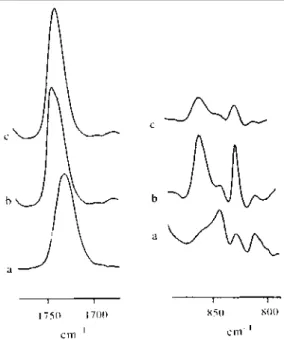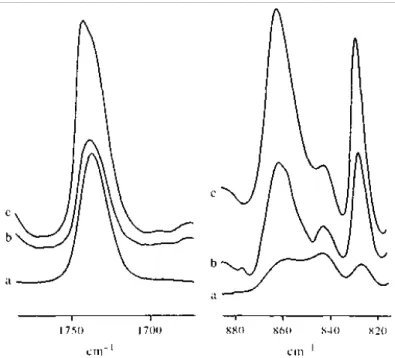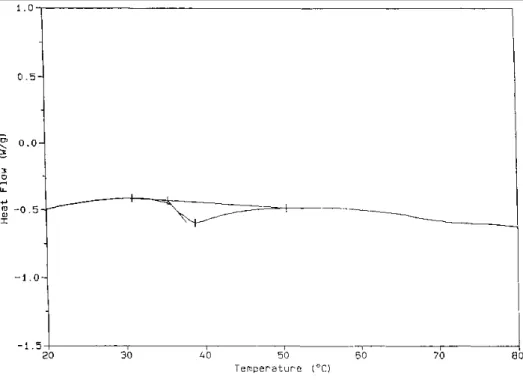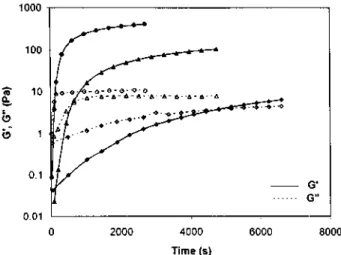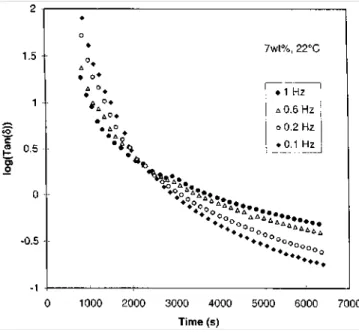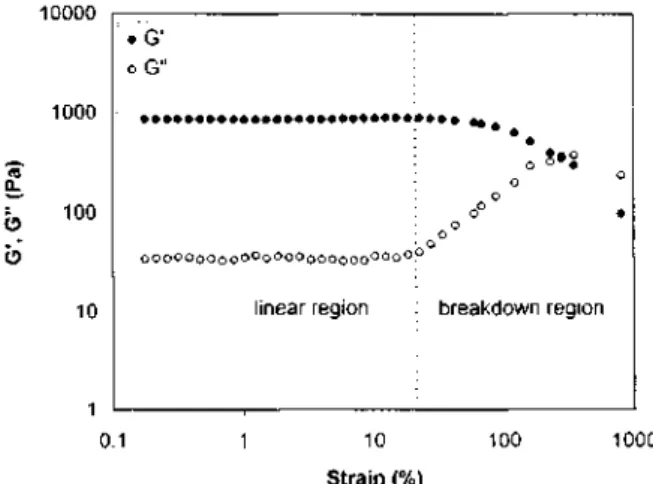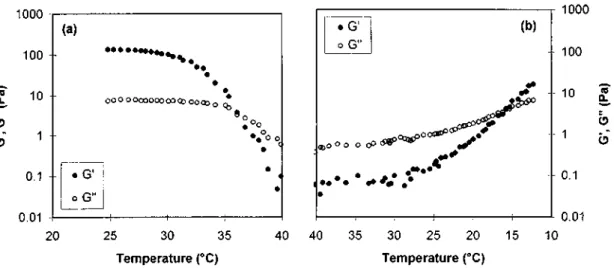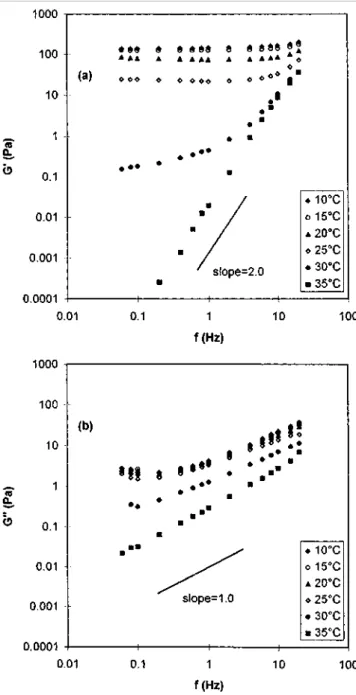Triblock copolymer based thermoreversible gels. 1: Self-association of
sPMMA end-blocks in o-xylene and viscoelasticity of the gels
Jian Ming Yu, Robert Jérôme, Philippe Teyssié
Center for Education and Research on Macromolecules, University of Liège, B6 Sart-Tilman, 4000 Liège, Belgium
Abstract
Syndiotactic poly(methyl methacrylate) (sPMMA)-polybutadiene (PBD)—sPMMA triblock copolymers, or MBM, have been studied in the presence of o-xylene which is a selective solvent for the central PBD block. Syndiotactic PMMA is known to self associate in o-xylene. The central PBD sequence does not prevent the self-association of sPMMA from occurring. Actually, this phenomenon contributes to the stability of the gels formed at room temperature. An endotherm is observed at 35°C, which is responsible for a gel-sol transition. The original solutions have been heated up to 80°C and then rapidly cooled down below 35°C and maintained at 10, 20 and 25°C respectively. The self-association of the sPMMA outer blocks, and thus the liquid—solid transition, have been studied at each of these temperatures. Dependence of the gel viscosity on frequency and temperature effects on viscoelasticity has also been investigated.
Keywords: gel; triblock copolymer; syndiotactic poly(methyl methacrylate)
INTRODUCTION
Since the discovery by Fox [1] that syndiotactic poly(methyl methacrylate) (sPMMA) could crystallize in the presence of some solvents, self-aggregation of sPMMA has been extensively studied [2-9]. Spevacek et al [5,6]. have shown that this phenomenon is strongly dependent on the PMMA stereoregularity and the solvent used. The aggregation takes place, even in dilute solutions, as the result of interactions between long parallel s-sequences; in some solvents, such as o-dichlorobenzene and o-xylene. In other solvents, such as acetonitrile and chloroform, the tendency to aggregation is negligible. It is worth noting, however, that the crystallization of sPMMA in the bulk, thus as promoted by a thermal treatment, has never been reported. The final structure of sPMMA solutions has been investigated by various techniques, such as n.m.r., i.r., X-ray and light scattering. Formation of extended helices in oriented swollen films has been shown by X-ray diffraction [3,4]. The solvent participates to the intermolecular association of sPMMA and it is incorporated into the ordered structure. I.r. observation confirms a regular chain conformation [5,6] and particularly the transition from a predominantly trans gauche (TG) to an all trans (TT) conformation when sPMMA is dissolved in o-xylene, in agreement with an increase in the intensity of the -CH2- rocking vibration at 860 cm-1 at the expense of the intensity of the
vibration at 843 cm-'. This intramolecular order is maintained after removal of the solvent.
Very recently, Berghmans et a/. [8,9]have investigated the mechanism for the thermoreversible gelation of homo-sPMMA solutions in o-xylene [8] and in toluene [9]. A two-step mechanism has been proposed, the first step of which is a fast intramolecular conformational change, followed by an intermolecular association into a tridimensional network. If the mechanism proposed by Berghmans et al.8 for the sPMMA gelation in o-xylene may be extended to the MBM triblocks, then a gel formation may be anticipated as sketched out in Scheme 1. It is also worth recalling that supercooled solutions of sPMMA, e.g. in o-xylene show a liquid (sol) to solid (gel) transition when the chain cross-linking (p) reaches a critical value, which is known as the gel point (GP). This gel formation has recently been studied extensively on the basis of the scaling concept and the percolation theory [10]. It has been shown that the dynamic mechanical behaviour at the GP may be described by a scaling
relationship between the dynamic moduli (G' and G'') and the angular frequency (Ω)[equation (l)] [11-15,18,19]
where f is the frequency and ∆ the scaling exponent.
As a rule, the loss angle at the gel point (δc), which is a measure of the phase difference between G' an G" (G"/G'
Scheme 1
Although many studies have been devoted to the solvent-induced association of sPMMA, no information is available on the behaviour of sPMMA when it is part of a block copolymer. This paper aims at studying the self-association of sPMMA outer blocks in sPMMA PBD-sPMMA triblock copolymers (MBM) in o-xylene, which is a selective solvent for PBD known to favour the sPMMA crystallization. This binary MBM/o-xylene system has been studied by i.r., d.s.c. and dynamic mechanical measurements as a function of time, temperature and MBM concentration.
EXPERIMENTAL
Materials
sPMMA and the PBD-sPMMA diblock copolymers (BM) were prepared by using the reaction product of s-BuLi with one equivalent of 1,1-diphenylethylene (DPE) as the initiator. The MBM triblock copolymer was prepared by using the diadduct of tBuLi onto m-diisopropenylbenzene (m-DIB) as a difunctional initiator. The detailed synthesis was described elsewhere [26]. Chemical composition and molecular weight of these materials are listed in Table 1. Molecular weight of the sPMMA block in MBM copolymer is quite comparable to that of the available homo-sPMMA. The stereoregularity of PMMA is the same in the three samples. Solutions of these (co)polymers in o-xylene were prepared at 80°C.
Table 1 Molecular characteristics of the studied (co)polymers Sample BD MMA 1.2%a s %b sPMMA 30 1.20 78 BM 80 40 1.10 44 78 MBM 80 2x25 1.10 41 78 a Content of 1.2 units in PBD
b Content of syndiotactic triads in PMMA
Characterization
I.r. spectra were recorded with the 600 FT i.r. Perkin-Elmer spectrometer. Thermal analysis (d.s.c.) was carried out with a Dupont 910 calorimeter in sealed pans at a heating rate of 20°Cmin-1. The dynamic mechanical measurements were performed with a Bohlin CS apparatus equipped with coaxial cylinders (d = 25 mm). The polymer solution, preheated at 80°C, was rapidly added between the coaxial cylinders thermo-stated at the requested temperature. The cooling of the solution from 80°C down to the measurement temperature needed ca. 1 min (as measured with a thermocouple) and the measurements were then immediately started. Equilibrium moduli were measured with samples aged for 7 days at 0°C by using the 20 mm parallel plate gemoetry. The gap setting was 1 mm. The concentration of the aged samples was calculated from the weight of the sample before and after the complete removal of the solvent.
RESULTS AND DISCUSSION
On cooling a solution of MBM prepared at 80°C in o-xylene, a transparent gel is formed. Conversely, the subsequent heating of this gel results in the formation of a transparent solution. This sol-gel transition is quite reversible. At room temperature, the gels are fragile at low concentration (< 5 wt%) and become stronger at higher concentration (> 10 wt%).
Infrared analysis
In order to elucidate the origin of the gel formation, the i.r. spectra of the parent sol and gel have been compared. Indeed the self-association of sPMMA in solvents, such as o-xylene, has been cleared up by i.r. and related to a change in the chain conformation. The most representative frequency ranges are those of the carbonyl stretching vibration (1700-1750 cm-1) and the -CH2-rocking vibration at 843 and 860 cm-1 for the TG and TT conformation,
respectively. Figure 1a shows the i.r. absorption at 1731 cm-1 for the C=O group of a MBM solution in CHCl3
(10wt%), in which the sPMMA self-association is known not to occur. In contrast, the 10wt% solution of MBM in o-xylene forms a gel, which after a 2-day ageing at room temperature shows an additional absorption at a higher wave number (1738 cm-1) (Figure 1b). When this gel is melted by heating up to 80°C, the absorption at 1738 cm-1 disappears and a symmetrical absorption band shape is observed for the C=0 stretching vibration at 1733 cm-1 (Figure 1c).
Figure 1 Partial FT i.r. spectrum of MBM triblock copolymer solution (10 wt%) at 25°C in (a) CHCl3; (b)
o-xylene; (c) o-xylene heated at 80°C
This might be indicative of dissociation of the polymer network stabilized by sPMMA intermolecular
association. Figure 1 also shows the 800—870 cm-1 absorption range. A well-defined band at 843 cm-1 together with a shoulder at 860 cm-1 are reported for the MBM chloroform solution (10 wt%) (Figure 1a). The intensity of the absorption at 860 cm-1 is dramatically increased at the expense of the peak at 843 cm-1 when the
copolymer forms a gel in o-xylene (10wt%, Figure 1b). This modification is characteristic of a transition from a random coil into a regular all-trans conformation [8]. This absorption pattern remains unmodified when the gel is melted by heating at 80°C (Figure 1c); except for a decrease in (relative) intensity. This observation indicates that the regular helix conformation of sPMMA persists upon the chain deassociation. The i.r. observations for the MBM copolymer in o-xylene confirm that the two-step mechanism proposed by Berghmans et a/. [8,9] for the self-association of homo sPMMA can be extended to the sPMMA outer blocks of MBM.
Figure 2 compares the typical absorptions for homo sPMMA, BM diblock copolymer and MBM triblock copolymer at the same concentration in o-xylene (10wt%) at 25°C. The i.r. absorption in the 840— 860 cm-1 range indicates that the regular all-trans conformation does not dominate in the solution of homo sPMMA (Figure 2a). This situation persists even at concentrations as high as 30%. The a\l-trans conformation is
considerably increased for sPMMA associated with PBD in a diblock structure (Figure 2b). Finally, this all-trans conformation is still more dominating the random coil conformation when sPMMA is part of a triblock
copolymer (Figure 2c). It is clear from Figure 2 that the conformation of sPMMA in o-xylene at 25°C is strongly dependent on the constraints resulting from the chemical bonding to an immiscible partner such as polybutadiene. The absorption due to carbonyl vibration (1700—1750 cm-1) is also shown in Figure 2. A symmetrical absorption for the sPMMA homopolymer is observed at 1731 cm-1, whereas this peak is slightly shifted toward higher wave numbers for the BM diblock copolymer solution. An additional absorption becomes very pronounced at higher wave numbers for the MBM triblock solution.
Figure 2 Partial FTi.r. spectrum of a 10 wt% solution in o-xylene at 25°C for (a) homo sPMMA; (b) BM diblock copolymer; (c) MBM triblock copolymer
This observation is in agreement with the macroscopic behaviour of these solutions, i.e. the sPMMA homopolymer solution does not form a gel even at 0°C for one week. Gelation of the MB diblock solution proceeds very slowly, i.e. after one day at 0°C, in contrast to gelation of the MBM triblock solution which is very fast, since it only requires a few minutes at 10°C to occur.
Calorimetric study
D.s.c. is a straightforward technique for the observation of a first order transition, such as the melting of gels formed by sPMMA. Figure 3 shows that an endotherm is observed upon heating a MBM gel in o-xylene (10 wt%). The enthalpy change for this transition is equivalent to 25 J g-1 sPMMA which is higher than the range 12.7— 17.0 J g-1 reported for homo sPMMA [8]. This is in agreement with the observation by i.r. that the PBD mid-block is favourable to sPMMA self-aggregation in o-xylene. The melting region extends over ca. 20°C from 35.5°C up to 55°C and shows a maximum at 39°C, which is lower than the value (~ 70°C) reported for homo PMMA of a comparable syndiotacticity [8].
Rheological studies
Time-behaviour of the MBM solutions in o-xylene: sol-gel transition. Since gelation of the sPMMA-PBD-sPMMA solutions in o-xylene is a time-dependent process, rheology of triblock copolymer solutions has been investigated as a means of probing the gelation process. A special attention has been paid to the time-dependence of the complex shear modulus of solutions of various concentrations, at three temperatures: 10°C, 20°C and 30°C, respectively.
Figure 3 D.s.c. thermogram for a 10wt% solution of MBM (Table 1) in o-xylene (heating rate: 20°C min-1)
Figure 4 Shear storage (G') and loss (G") moduli vs. time at 20°C and 1 Hz for MBM solutions in o-xylene of various concentrations: 6wt% (○, ●), 7wt% (◊,
♦
), 8wt% ( , ▲), 9wt% (□, ■)Figure 4 illustrates how the shear storage modulus (G') and the shear loss modulus (G") depend on time at a constant frequency of 1 Hz and a constant temperature of 20°C for solutions of various concentrations originally prepared at 80°C. Only the most relevant part of the curves is shown, i.e. until approaching the plateau region where the moduli are independent of time which may require more than 24h. Originally, the loss modulus G" is higher than G' which is a characteristic feature of liquids. Both the moduli increase with time as a result of an increasing aggregation of the sPMMA blocks, the conformation of which changes from a random coil conformation to the regular all-trans conformation prone to self association. The elastic component of the complex modulus however rises more sharply than the viscous component, so that the two curves intersect at G' = G". Beyond that point, G" rapidly tends to a constant value, whereas G' goes on slowly increasing. Although the time requested for G' and G" to be equal is designated as the gel point by some authors [23,24], a more rigorous definition of the gel point has been given by Winter et al. [11] as the point where tan δ (= G"/G') is independent of frequency. The definition by Winter will be used in this paper, whereas the point where G' = G" will be referred to as the crossover point and the related time the crossover time. When the solution
concentration is changed, the general behaviour, reported in Figure 4 remains unchanged except for the magnitude of the moduli which increases with concentration and the crossover time which decreases.
Figure 5 shows how the time dependence of G' and G" for a 8wt% solution of MBM changes with temperature (1 Hz). The observed tendency for the moduli to decrease and the crossover time to increase upon increasing
temperature is in agreement with the thermal dissociation of the sPMMA aggegates that stabilize the chain network. A decrease in the density of physical crosslinks accounts for the experimental observation, which shows that increasing temperature has the same effect as decreasing the polymer concentration.
Frequency effect. In order to get a better insight into the gelation of supercooled MBM solutions in o-xylene, the time dependence of the loss modulus (G") and the storage modulus (G') have been measured at different
frequencies, and particularly at low frequencies which less perturb the intermolecular association of the sPMMA outer blocks. Solutions of a 7wt% concentration have been prepared at 80°C and then quenched to 22°C and kept at this temperature for isothermal gelation.
Figure 5 Shear storage (G') and loss (G") moduli vs. time for a 8 wt% solution of MBM in o-xylene at 10°C (○, ●), 20°C (∆, ▲) and 25°C (◊,
♦
). The frequency is 1 Hz (6.28 rads-1)Figure 6 Shear storage (G') and loss (G") moduli vs. time at 22°C for a 7 wt% solution of MBM in o-xylene at four frequencies (○, ●: 0.1 Hz, □, ■: 0.2Hz, ◊, ♦: 0.6 Hz, , ▲: 1 Hz)
This temperature is appropriate to analysis because the sPMMA aggregation is slow enough for the solution properties to be considered as constant during the time required for the individual measurements of G' and G". Figure 6 shows the storage (G') and loss (G") moduli as a function of time at frequencies 0.1, 0.2, 0.6 and 1 Hz, respectively. The transition from a viscoelastic liquid to a viscoelastic solid at G' = G" strongly depends on frequency. Indeed, the crossover time and the modulus at the crossover point increase with increasing frequency. It is worth pointing out that the linear time dependence of G' beyond the 'gel point' and thus the slope of this straight line is independent of frequency.
It is known that the polymer at the gel point has no intrinsic size scale, except for the average distance between the cross-links. The statistic structure and the relaxation modes are self-similar and the dynamic mechanical behaviour at the gel point fits a power law for the frequency dependence of the moduli [equations (1) and (2)].
Although these dynamic mechanical properties are characteristic of polymers at the gel point of chemically cross-linked systems, there is now evidence for their validity for physically cross-linked systems [14-22].
Figure 7 Tan δ vs. time for four frequencies at 22°C for the same sample as in Figure 6
The percolation theory has predicted a value of 0.67 for ∆ which has been experimentally confirmed in the case of chemical gelation. Indeed, ∆ has been found to be 0.7 for epoxy resins [19] and 0.69 for polyurethanes [21] at the gel point. When physical gelation is concerned Winter et al. have observed the same behaviour at the gel point with ∆ = 0.125 [14] and 0.11 [22] for the crystallization-induced gelation of poly(propylene) and poly(β-hydroxyoctanoate) respectively.
In order to confirm the similarity between physical gelation and the more widely studied chemical gelation, tan δ has been plotted as a function of time at several frequencies (0.1, 0.2, 0.6, 1 Hz) in Figure 7. As it is expected for a self-similar behaviour, the loss angle for the MBM polymer at the gel point is independent of frequency. It also appears from Figure 7 that the gel point is reached after 2200 s at 22°C. Before the gel point, tan δ decreases with increasing frequency, as is typical for a viscoelastic liquid. Beyond the gel point, tan δ increases with frequency which is characteristic of a viscoelastic solid. Clearly, the sample has changed from a viscoelastic liquid to a viscoelastic solid. At the gel point, log(tan δ) = 0.29, which corresponds to ∆ = 0.70, in good agreement with theory and experimental values observed for chemical gelation.
Gel at pseudo-equilibrium state. Since it takes more than 24 h for G' to reach a constant value at 10°C, gels have been aged for 7 days at 0°C before any rheological measurement is carried out. Figure 8 shows the strain dependence of G' and G" for a 8wt% solution of MBM in o-xylene at 10°C. In a strain range from 0.1% to 1000%, two distinct regions are observed. When strain is smaller than 10%, the moduli remain constant. At larger strains, the linear region is no longer observed, the storage modulus G' decreases and the loss modulus G" goes through a maximum due to the gel breakup.
The frequency dependence of G' for aged gels of various concentrations in o-xylene is shown in Figure 9. At low frequencies, G' is constant, whereas G" is smaller by several orders of magnitude and negligible.
Figure 8 Shear storage (G') and loss (G") moduli vs. strain a t Hz for a 8wt% solution MBM in o-xylene aged at 0°C for 7 days
Figure 9 Frequency sweep of MBM gels in o-xylene at 10°C and four concentrations indicated in the legend. Samples were aged for 7 days at 0°C
The constant value of G' can accordingly be considered as the equilibrium shear modulus, Ge. Values of Ge at
different concentrations are listed in Table 2; they regularly increase with concentration at least in the investigated range. According to the classical rubber theory [16],
Ge = cRT/Mc (3)
where Mc is the molecular weight between crosslinks and c the polymer concentration in o-xylene. Figure 10
shows the log-log plot of Ge vs. c. If equation (3) is valid to the system under investigation, the slope of Figure
10, which is actually a straight line, should be 1. Actually, this slope is 3.0 and the dependence of Ge on c obeys
a power law [equation (4)]
Ge = kc'" (4)
This conclusion is not unusual, since the same type of relationship has been experimentally observed for highly elastic Kappa-carageenan gels [17] with an exponent m of 3.16. Table 2 also shows the melting temperature (Tm)
for MBM gels of various concentrations at the crossover point (G' = G"). The value of Tm which is in good
Figure 10 Equilibrium modulus Ge vs. concentration of copolymer for MBM gels in o-xylene at 1 Hz at 10°C
Effect of temperature. In contrast to chemical cross-linking where Ge increases with temperature, Ge of physical
gels decreases upon increasing temperature. This is the straightforward consequence of the thermal dissociation of the physical crosslinks which are, in this case, crystalline aggregates of the sPMMA blocks of the MBM copolymers.
Figure 11 shows the change in moduli which is observed when the gel is heated throughout the melting range (Figure 11a) and then reformed upon cooling down to ca. 10°C (Figure 11b). On heating, the gel persists up to 35°C (with G' > G"), while it reforms on cooling at a much lower temperature (18°C) (G' = G"). This
observation agrees with a large hysteresis for the melting and reformation of the MBM gel in o-xylene at the heating and cooling rates of l°C min-1.
Frequency sweep of G' and G" at a constant temperature in the 10-35°C interval is shown in Figure 12 for a sample (6wt%) aged at 10°C for 24 h. At low temperature (<25°C), G' is essentially independent of frequency, whereas the dependence of G" on frequency is rapidly a straight line (Ω > 5 s-1) with a slope of ~ 0.69. It is worth noting that this value is very close to the scaling exponent, A, found at the gel point [equation (2)]. This
correspondence has been attributed to residual fractality in the network by Adolf et al. [25]. When the gel starts to melt (e.g. 30°C, see also Figure 3), the ωdependence of G' rapidly increases with temperature. Actually, n (for G' ~ ω") changes from 0.02 at 25°C to 2.0 at 35CC, In parallel, the ω-dependence of G" changes quite
moderately with temperature, since the exponent n varies from 0.69 at 25°C to 1.0 at 35°C. While the gel melting occurs (35°C), the loss modulus closely matches the anticipated G" ~ Ω law for a viscoelastic liquid [16]. Time-temperature superposition does not work in this Time-temperature interval since a gel-sol transition occurs.
Figure 11 Thermal dependence of the shear storage (G') and loss (G") moduli at 1 Hz, when a 7 wt% MBM gel in o-xylene is melted (a) and allowed to reform on cooling (b) (rate: l°C min-1)
Figure 12 Frequency sweep of a MBM gel (6 wt%) in o-xylene in the 10-35°C interval. The sample was aged at 10°C for 24h
CONCLUSION
This paper has shown that a sPMMA—PBD—sPMMA triblock copolymer in which the outer sPMMA blocks are 77% syndiotactic forms thermoreversible gels in o-xylene by intra- and intermolecular association of the sPMMA component. The flexible polybutadiene mid-block does not hinder this association. Actually, gelation which results from the sPMMA self-association, is favoured for triblock copolymer compared to homo-PMMA of comparable molecular weight and tacticity. The propensity of the BM diblock copolymer to gelation is intermediate between the MBM triblock copolymer and the homopolymer. Nevertheless, gels formed by the triblock copolymer (Tm = 35°C) are thermally less stable than gels of homoPMMA (Tm = 70°C) of a comparable
tacticity.
Gelation of MBM triblock copolymer in o-xylene essentially depends on polymer concentration and
temperature. As a rule, increasing concentration has a comparable effect on the gelation process as decreasing temperature, i.e. a shorter gelation time and a higher elastic modulus.
At the gel point, where the loss angle, tan δ = G"/G', is independent of the probing frequency, the sample obeys a typical power law G' ~ G" ~ ω∆, with the scaling exponent A found equal to 0.70.
ACKNOWLEDGEMENTS
The authors are very much indebted to the Flemish Institute for the Promotion of Science-Technological Research in Industry (IWT) for the financial support of a joint research programme with Raychem N.V. (Kessel-Lo, Belgium) and the Katholieke Universiteit Leuven (Prof. H. Berghmans and H. Reynaers). They warmly thank Dr N. Overbergh (Raychem, Kessel-Lo), Dr Ph. Hammond and Dr J. Hudson (Raychem, Swindon), Dr Ph. Dubois and Dr S. Blacher (Liége, Belgium) for stimulating discussions. They are grateful to the 'Services Federaux des Affaires Scientifiques, Techniques et Culturelles' for general support in the frame of the Poles d'Attraction Interuniversitaires: Polymères.
REFERENCES
[1] Fox. T. F., Garrett, B. S., Goode, W. E., Gratch, S., Rincaid. J. F., Spell. A. and Stroupe, J. D. J. Am. Chem. Soc. 1958, 80, 1768 [2] Spevacek, J., Schneider, B. and Straka. J. Macromolecules 1990, 23, 3042
[3] Kusuyama, H., Takase, M., Higashihata, Y., Tseng, H. T., Chatani, Y. and Tadokoro, H. Polymer 1982, 23, 1256 [4] Kusuyama, H., Miyamoto, N., Chatani, Y. and Tadokoro, H. Polym. Commun. 1983, 24, 119
[5] Spevacek, J., Schneider, B., Baldrian, J., Dybal, J. and Stokv, J. Polym. Bull. 1983, 9, 495
[6] Spevacek, J., Schneider, B., Dybal, J., Stokv, J. and Baldrian, J. J. Polym. Sci., Polym. Phys. Ed. 1984, 22, 617 [7] Spevacek, J. and Schneider. B. Adv. Colloid. Interface Sci. 1987, 27, 81
[8] Berghmans, H., Donkas, A., Frenay, L., Stoks, W., De Schryver, F. E., Moldenaers, P. and Mewis, J. Polymer 1987, 28, 97 [9] Berghmans, W., Thijs, S., Cornette, M., Berghmans, H., De Schryver, F. C Moldenaers, P. and Mewis. J. Macromolecules 1994, 27, 7669
[10] de Gennes, P. G. 'Scaling Concepts in Polymer Physics', Cornell University Press, Ithaca, New York, 1979 [11] Winter, H. and Chambon, F. J. Rheol. 1986, 30, 367
[12] Chambon, F., Petrovic, Z. S„ MacKnight, W. J. and Winter, H. H. Macromolecules 1986, 19, 2146 [13] Te Nijenhuis, F. and Winter, H. H. Macromolecules 1989, 22, 411
[14] Lin, Y. G., Mallin, D. T., Chien. J. C. W. and Winter, H. H. Macromolecules 1991, 24, 850 [15] Chambon, F. and Winter, H. H. Polym. Bull. 1985, 13, 499
[16] Ferry, J. P. 'Viscoelastic Properties of Polymers', 3rd edn., 1980 [17] Watase, M. and Nishinari, K. Colloid. Polym. Sci. 1982,260, 971 [18] Hodgson, P. and Amis, E. J. Macromolecules 1990, 23, 2512
[19] Adolf, D., Martin, J. E. and Wilcoxon. J. P. Macromolecules 1990.23.527 [20] lzuka. A., Winter, H. H. and Hashimoto. T. Macromolecules 1992, 25, 2422 [21] Durand, D., Delsanti, M., Adam, M. and Luck, J. M. Europhvs. Lett. 1987, 3, 297
[22] Richtering, H. W., Gagnon, K. D., Lenz. R. W., Fuller. R. C. and Winter, H. H. Macromolecules 1992, 25, 2429 [23] Djabourov, M., Leblond, J. and Papon, P. J. Pins. France 1988, 49, 333
[24] Tung, C. M. and Dynes, J. J. Appl. Polym. Sci. 1982, 27, 569 [25] Adolf, D. and Martin, J. E. Macromolecules 1991, 24, 6721

